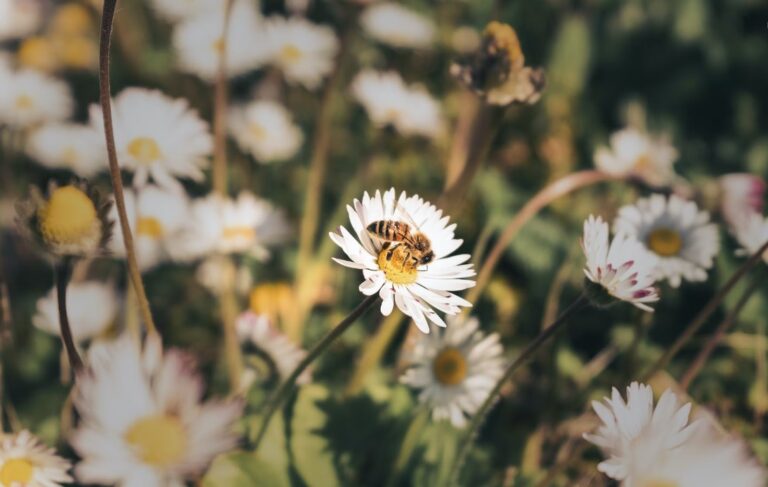Bees are more than just summertime buzzers. Despite the annoyance they might cause on hot days, bees play a vital role in our lives. They pollinate about one-third of our food, from fruits to cocoa beans. I
Flowers give bees their energy and protein. Pollen, on the other hand, is their protein source. Many garden plants serve as a buffet for bees, offering both nectar and pollen. So, when you’re out gardening, remember to pick flowers that help the bees. It’s a small act that benefits our planet.
Table of Contents
1. Allium
Botanical Name: Allium spp.
Sun Exposure: Full sun
Soil Type: Rich, well-drained, sandy loam
Soil pH: Slightly acidic
Alliums, a type of ornamental onion, have flowers that attract pollinators. Their blossoms vary from small clusters to big pom-poms. They’re usually planted in fall using bulbs. Remember, these aren’t the edible kind of onions, so it’s best to let bees enjoy them.
2. Asters
Botanical Name: Aster, Eurybia, Symphyotrichum spp.
Sun Exposure: Full sun to partial shade
Soil Type: Moist, well-drained
Soil pH: Varies
Asters come with small, daisy-like blooms. Even if their classifications have changed over time, bees still love them. Most asters found in garden centers bloom in summer or fall. They like full sun and moist soil. Some even prefer a bit of shade during hot mid-day.
3. Beardtongue
Botanical Name: Penstemon spp.
Sun Exposure: Full sun
Soil Type: Well-drained, sandy (some can handle clay)
Soil pH: Varies
Penstemons belong to a big flower family. Many are native to mountains and dry places. If you’re planting one from the southeast, it’ll probably need more water. Their colorful spikes are a hit with pollinators. Plus, there’s a special green bee that relies solely on these flowers.
4. Bee Balm
Botanical Name: Monarda didyma
Sun Exposure: Full sun to partial shade
Soil Type: Moist, well-drained clay
Soil pH: Acidic to neutral
Just as its name suggests, bee balm is a favorite for bees. It thrives in moist soil. One thing to watch out for is powdery mildew. Some varieties, like ‘Raspberry Wine,’ are resistant to this issue. There are other bee balm species with different colored flowers, and bees will gladly visit any of them.
5. Black-Eyed Susan
Botanical Name: Rudbeckia hirta, R. fulgida
Sun Exposure: Full sun to partial sun
Soil Type: Well-drained, ranging from loam to sand to clay
Soil pH: Acidic to alkaline
Black-Eyed Susans brighten up the garden, especially during the hot summer months when other plants tire out. Bees adore their nectar and pollen-rich centers. And come fall, even goldfinches join the party for seeds. R. hirta might not last long, but it easily spreads, mostly sprouting bright yellow flowers. R. fulgida, the orange coneflower, is a long-lasting, golden-rayed beauty. Both are sturdy prairie flowers that earn their garden spot.
6. Blue Salvia/Sage
Botanical Name: Salvia spp.
Sun Exposure: Full sun
Soil Type: Well-drained, rich
Soil pH: Slightly acidic to neutral
Pick any shade of blue – sky, lavender, or deep indigo – and you’ve got a blue sage that bees can’t resist. Their strong, upright flower spikes can charm for months, especially with a bit of trimming. Best part? Most animals steer clear of its fragrant leaves.
7. Catmint
Botanical Name: Nepeta x faassenii
Sun Exposure: Full sun to partial shade
Soil Type: Anything from clay to sandy to rocky
Soil pH: Acidic to alkaline
Both gardeners and bees have a soft spot for catmint. Thanks to its fragrant leaves and plenty of purple flowers. It’s a growing machine, often more than you might want, but it’s manageable. A little trimming here and there even gets it blooming again.
8. Chives
Botanical Name: Allium schoenoprasum
Sun Exposure: Full sun to light shade
Soil Type: Rich, well-drained
Soil pH: Slightly acidic to neutral
Chives aren’t just another onion flower; they hold a special spot in herb gardens. Before you chop their leaves for your dishes in spring, wait a bit. Their slender leaves bloom with lovely lavender-pink flowers. Once they start fading, you can trim them off. Compared to other alliums, chives like a bit more shade and moisture.
9. Cleome
Botanical Name: Cleome Houtteana
Sun Exposure: Full sun
Soil Type: Well-drained, including rocky, clay, and loam
Soil pH: Mildly acidic to neutral
Often called the spider flower, Cleome is a delight, even for those wary of spiders. They come in colors like pink, purple, and white. Whether you plant them from seeds or buy from a store, they grow fast. They keep blooming from early summer until frost sets in. For the taller ones, place them at the back of your garden. They add a touch of charm.
10. Goldenrod
Botanical Name: Solidago spp.
Sun Exposure: Full sun to partial sun
Soil Type: Clay, loam
Soil pH: Acidic
Goldenrods are a bee magnet, especially in the fall. Bees of all sizes, from tiny ones to big carpenter bees, can’t resist them. They’re a late-season feast for bees. Goldenrods are easy growers, not fussy about where they stand. While most prefer sunny spots with well-drained soil, the zigzag goldenrod can adapt to wooded areas. Once they settle in, they spread quickly. It’s a joy to see them grow and even share with others.
Read also: Bee extinction: all the risks and severe dangers it poses












